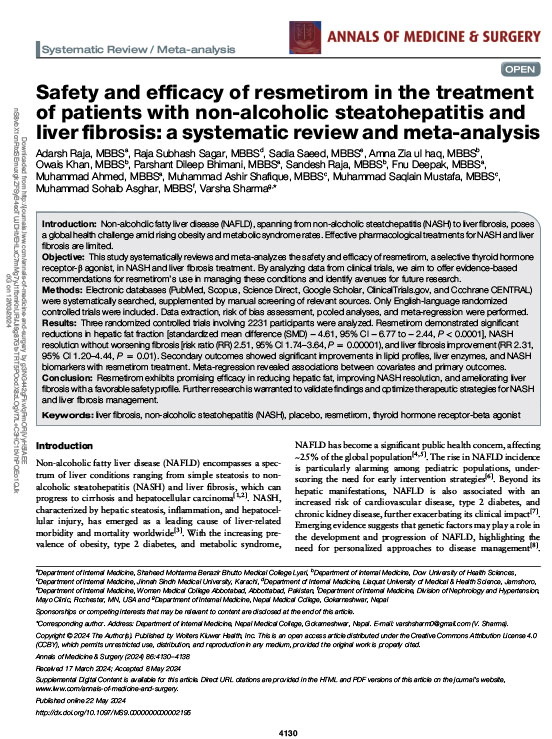Safety and efficacy of resmetirom in the treatment of patients with non-alcoholic steatohepatitis and liver fibrosis: a systematic review and meta-analysis
July 2024
Annals of Medicine & Surgery
Introduction: Non-alcoholic fatty liver disease (NAFLD), spanning from non-alcoholic steatohepatitis (NASH) to liver fibrosis, poses a global health challenge amid rising obesity and metabolic syndrome rates. Effective pharmacological treatments for NASH and liver fibrosis are limited.
Objective: This study systematically reviews and meta-analyzes the safety and efficacy of resmetirom, a selective thyroid hormone receptor-β agonist, in NASH and liver fibrosis treatment. By analyzing data from clinical trials, we aim to offer evidence-based recommendations for resmetirom’s use in managing these conditions and identify avenues for future research.
Methods: Electronic databases (PubMed, Scopus, Science Direct, Google Scholar, ClinicalTrials.gov, and Cochrane CENTRAL) were systematically searched, supplemented by manual screening of relevant sources. Only English-language randomized controlled trials were included. Data extraction, risk of bias assessment, pooled analyses, and meta-regression were performed.
Results: Three randomized controlled trials involving 2231 participants were analyzed. Resmetirom demonstrated significant reductions in hepatic fat fraction [standardized mean difference (SMD) − 4.61, 95% CI −6.77 to −2.44, P < 0.0001], NASH resolution without worsening fibrosis [risk ratio (RR) 2.51, 95% CI 1.74–3.64, P = 0.00001), and liver fibrosis improvement (RR 2.31, 95% CI 1.20–4.44, P = 0.01). Secondary outcomes showed significant improvements in lipid profiles, liver enzymes, and NASH biomarkers with resmetirom treatment. Meta-regression revealed associations between covariates and primary outcomes.
Conclusion: Resmetirom exhibits promising efficacy in reducing hepatic fat, improving NASH resolution, and ameliorating liver fibrosis with a favorable safety profile. Further research is warranted to validate findings and optimize therapeutic strategies for NASH and liver fibrosis management.


